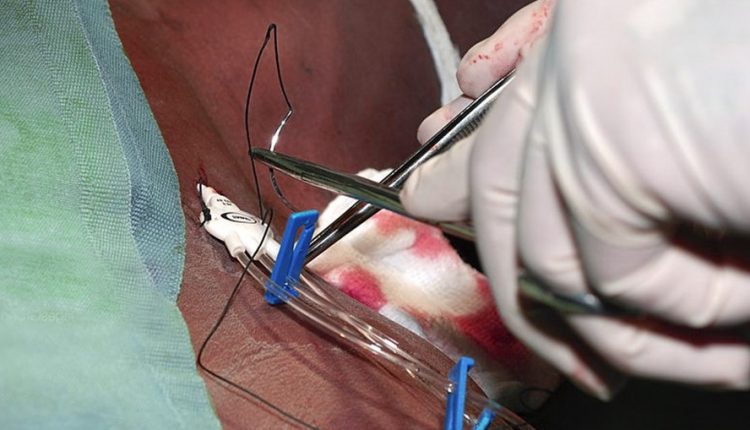
Central venous catheter (CVC): placement, management, and guidelines
The central venous catheter (CVC) is a medical device that is inserted into one of the central veins (subclavian, femoral, or internal jugular vein)
The catheter is a long, thin, rigid or flexible tube of various materials, about 20 centimeters long and several millimeters in diameter.
Central venous catheter: why is it used?
The CVC is very useful for all situations in which you want to put a substance into the bloodstream.
Typical examples are the infusion of fluids (saline, drugs…) and total parenteral artificial nutrition, in which nutrients are introduced into the body, “bypassing” the digestive system.
In the part of the catheter outside the skin, access routes are provided for different types of infusion (these routes generally have a differentiated lumen between them and are independent of each other).
When to prefer a central venous catheter to a peripheral one?
A venous catheter can be inserted not only centrally but also peripherally, an eventuality in which it is usually placed in a superficial vein of the arm (cephalic, median, basilic, radial, ulnar).
There are several reasons why a physician may use a central access route instead of the less invasive peripheral route.
Generally, the central route is preferred when long-term therapy is planned: the central venous catheter can, in fact, remain in place for a long time, longer than a peripheral catheter.
A typical example is total parenteral nutrition, in which the central venous catheter remains in place for long periods.
Central venous catheter: what are the advantages?
The advantages of placing a CVC mainly relate to the ability to provide for the administration of drugs, fluids, or medications in patients who need them (patients who need medication administration for long periods of time, for example, or who need parenteral nutritional therapies).
How is the placement of a central venous catheter performed?
- the patient signs an informed consent;
- the catheter insertion site is shaved;
- the patient sits on the crib in the angiography room;
- the interventional radiologist studies the vein of interest with the ultrasound scanner and proceeds with local anesthesia;
- still under ultrasound guidance, the physician reaches the central vein with a needle-cannula, within which a thin wire is placed that will serve as a guide to slide the catheter;
- following insertion, an X-ray is taken to verify its correct location.
Insertion of a CVC should be performed in a sterile environment.
Central venous catheter placement: how long does it take?
In total, the procedure takes about 15 minutes.
Central venous catheter: how do you prepare for it?
Unless otherwise advised by a physician, there are no special preparation rules.
Is central venous catheter placement painful or dangerous?
Central venous catheter placement is performed under local anesthesia and is not considered a painful procedure.
Is CVC placement dangerous?
CVC placement is performed under local anesthesia and is not considered a risky procedure if performed by experienced personnel and in a sterile environment.
However, some complications can occur.
CVC: risks and complications
The main complications associated with catheter insertion are infections-the catheter provides direct access to microbes that from the external environment can enter the venous circulation and, therefore, the body-and occlusions, due to the eventual formation of drug precipitates or clots within the catheter.
When the catheter is inserted into the subclavian veins, one can, in very rare cases, encounter complications involving the lung, particularly collapse (pneumothorax).
Finally, if the catheter is not placed correctly, mechanical complications such as stapling or crushing of a section of the catheter or rupture of the catheter itself can occur.
Central venous catheter: contraindications
Particular contraindications in undergoing the placement of a central venous catheter exist for individuals suffering from blood clotting-related problems, patients being treated with anticoagulant drugs, and individuals with cardiovascular disease, diabetes, or hypotension.
Since catheter insertion is done under radiological control, pregnant women cannot undergo this type of treatment.
Particular attention should be paid to subjects with hypersensitivity or allergy to the contrast media used to monitor the catheter insertion that takes place under radiological guidance.
Home CVC: management and follow-up
Management of central venous access can also be done at home, paying attention to the insertion point.
It is important to have sterile gloves and gauze, saline solution, antiseptic cleansers, and band-aids to cover both the insertion point of the central venous catheter and the bowtie that attaches the catheter to the skin.
Renewal of the dressing is recommended every 48/72 hours with porous plaster or 5/7 days with clear plastic plaster and in any case whenever the insertion point is dirty or moist.
Read Also:
Emergency Live Even More…Live: Download The New Free App Of Your Newspaper For IOS And Android
Deep Vein Thrombosis Of The Upper Limbs: How To Deal With A Patient With Paget-Schroetter Syndrome
Transcatheter Ablation: What It Is And When To Use It
COVID-19, The Mechanism Of Arterial Thrombus Formation Discovered: The Study
The Incidence Of Deep Vein Thrombosis (DVT) In Patients With MIDLINE



